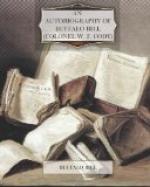“We are not as many as the White Man. But we know that this land is our land. And while we live and can fight, we will fight for it. If the White Man does not want us to fight, why does he take our land? If we come and build our lodges on the White Man’s land, the White Man drives us away or kills us. Have we not the same right as the White Man?”
The forfeiture of the Black Hills and unwise reduction of rations kept alive the Indian discontent. When, in 1889, Congress passed a law dividing the Sioux reservation into many smaller ones so as to isolate the different tribes of the Dakota nation a treaty was offered them. This provided payment for the ponies captured or destroyed in the war of 1876 and certain other concessions, in return for which the Indians were to cede about half their land, or eleven million acres, which was to be opened up for settlement.
The treaty was submitted to the Indians for a vote. They came in from the woods and the plains to vote on it, and it was carried by a very narrow majority, many of the Indians insisting that they had been coerced by their necessities into casting favorable ballots.
Congress delayed and postponed the fulfillment of the promised conditions, and the Indian unrest increased as the months went by. Even after the land had been taken over and settled up, Congress did not pass the appropriation that was necessary before the Indians could get their money.
Sitting Bull was appealed to for aid, and once more began employing his powerful gift of oratory in the interest of armed resistance against the white man.
Just at this time a legend whose origin was beyond all power to fathom became current among the red men of the north.
From one tribe to another spread the tidings that a Messiah was to come back to earth to use his miraculous power in the interest of the Indian. The whites were to be driven from the land of the red man. The old days of the West were to be restored. The ranges were to be re-stocked with elk, antelope, deer, and buffalo.
Soon a fever of fanaticism had infected every tribe. Not alone were the Sioux the victims of this amazing delusion, but every tribe on the continent shared in it.
There was to be a universal brotherhood of red men. Old enmities were forgotten. Former foes became fast friends. The Yaquis in Mexico sent out word that they would be ready for the great Armageddon when it came. As far north as Alaska there were ghost dances and barbaric festivities to celebrate the coming restoration of the Indian to the lands of his inheritance.
And as the Indians danced, they talked and sang and thought of war, while their hatred of the white man broke violently forth.
Very much disquieted at the news of what was going on the War Department sent out word to stop the dancing and singing. Stop it! You could as easily have stopped the eruption of Mount Lassen! Among the other beliefs that spread among the Indians was one that all the sick would be healed and be able to go into battle, and that young and old, squaws and braves alike, would be given shirts which would turn the soldiers’ bullets like armor-plate.




